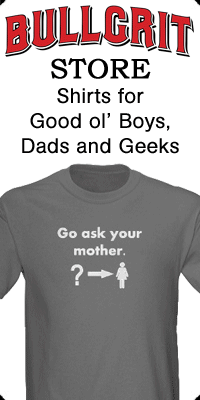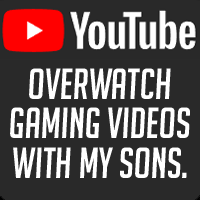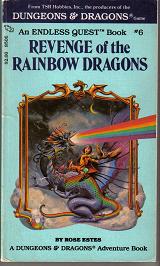 I was first introduced to the author Rose Estes through the Endless Quest book series of the 1980s. The Endless Quest books allowed you to control the decision making of the main character. For example, in the book, Revenge of the Rainbow Dragons, the reader is the character Jaimie, a wizard’s apprentice:
I was first introduced to the author Rose Estes through the Endless Quest book series of the 1980s. The Endless Quest books allowed you to control the decision making of the main character. For example, in the book, Revenge of the Rainbow Dragons, the reader is the character Jaimie, a wizard’s apprentice:
“We will let Jaimie decide. As my apprentice and the heir to this kingdom, Jaimie must learn to make good, sound decisions,” says Pentagarn. And suddenly there are three pairs of eyes staring at you.
“Well,” you stammer, thinking quickly, “the way I see it, we have only two choices:
1) “Go to Rainbow Castle and see if we can work our our problems with our neighbors.” Turn to page 110.
2) “Ignore them and don’t go.” Turn to page 83.
Throughout the story, the reader must make many such choices. Walk down the dark tunnel or head further down the lighted hallway. Take the jeweled pendant off the pedestal or leave it be. Talk to the strange creature or run away or attack with your dagger. As a Dungeon & Dragons player in the 80s, I found these books moderately entertaining. At its core, D&D was a game of these kinds of choices, but the books could never match the intricacies and imagination of the game. Plus, the books use no game mechanics (rules and dice), so there was no way to replicate the real game experience with just static text.
As literature, the books were for children. The writing was weak. J.K. Rowling’s writing is much better even in her first book. But I read several of the Endless Quest books. They are all very small: less than 200 pages — and you may only read 50 pages depending on your choices through the adventure. Usually I’d go back and read them a second and third time to see where else the story would take me through making other choices.
I never really thought about the author. But then one of my favorite fantasy worlds was tainted by this children’s author. The World of Greyhawk (WoG) is a classic fantasy fiction setting from Dungeons & Dragons. It was created by E. Gary Gygax for the D&D game, and I experienced the world’s evolution through the game publications and with two Gygax novels. From the mid 70s to the mid 80s, WoG was the quintessential D&D game world.
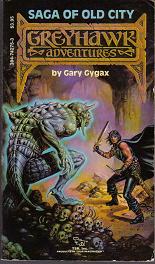 Gygaxian prose is dense with unnecessary archaic language, but it had a specific style; it was “serious” and “adult.” In the mid 80s, Gygax lost ownership of WoG (as well as D&D in general). The first new book for WoG, after the Gygax-D&D separation, was written by Rose Estes.
Gygaxian prose is dense with unnecessary archaic language, but it had a specific style; it was “serious” and “adult.” In the mid 80s, Gygax lost ownership of WoG (as well as D&D in general). The first new book for WoG, after the Gygax-D&D separation, was written by Rose Estes.
I was excited for a new WoG book; it was my favorite fantasy world — even better to me, as a setting, than Middle Earth from J.R.R. Tolkien’s Lord of the Rings. But Rose Estes’s writing was . . . disappointing. Abysmal. Atrocious. Crap. I was actually shocked by how bad it was — the writing style, the story, and how it was ruining such a great fantasy world. But someone at TSR (the publisher of D&D and WoG at the time) loved her, because she was allowed to write five or six more WoG novels.
Among WoG fans, Rose Estes is a hack — a bad children’s author who sucked the life out of a great fantasy setting. I really can’t say that I blame her too much, though, because she just did what she does: she wrote books. The villain in this “setting character assassination” is the jackhole who hired her to write for WoG. Once could be considered a mistake, but six times is villainy.
I recently rediscovered one of Estes’s Endless Quest books — Revenge of the Rainbow Dragons — among my stock of books, and upon reading it again, I had all these sour feelings come up again.
Bullgrit
bullgrit@totalbullgrit.com






 Categories:
Categories: 


 I was first introduced to the author Rose Estes through the
I was first introduced to the author Rose Estes through the  Gygaxian prose is dense with unnecessary archaic language, but it had a specific style; it was “serious” and “adult.” In the mid 80s, Gygax lost ownership of WoG (as well as D&D in general). The first new book for WoG, after the Gygax-D&D separation, was written by Rose Estes.
Gygaxian prose is dense with unnecessary archaic language, but it had a specific style; it was “serious” and “adult.” In the mid 80s, Gygax lost ownership of WoG (as well as D&D in general). The first new book for WoG, after the Gygax-D&D separation, was written by Rose Estes.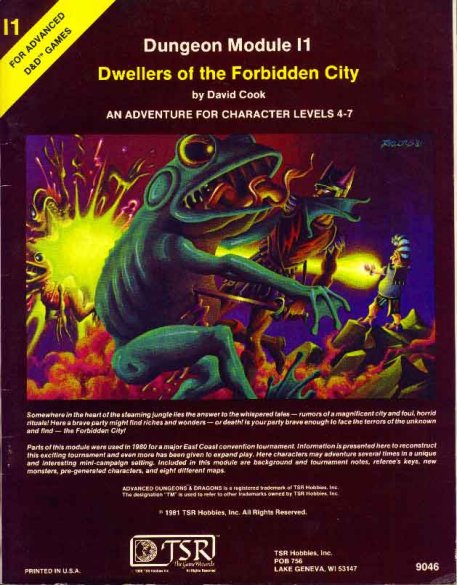 Classic D&D adventure module review
Classic D&D adventure module review